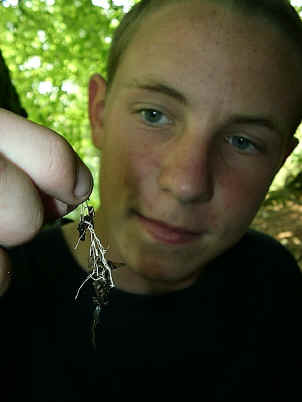Decomposition
| The following images show the gradual changes taking
place as the body of a dead rabbit decomposes over a period of 5 months. Most of the visual changes take place during the first two months and
then the process slows down. Click on the dates to view a larger image or click on the Slide Show. |
|
||||||||||
.
What is decomposition? |
|
| .Decomposition is the natural process of dead animal or plant tissue being rotted or broken down. This process is carried out by invertebrates, fungi and bacteria. The result of decomposition is that the building blocks required for life can be recycled. | |
|
Left: The body of a dead rabbit after several weeks of decomposition. Most of the flesh has been eaten by beetles, beetle larvae, fly maggots, carnivorous slugs and bacteria. The outline of the skeleton is starting to appear. |
All living organisms on earth will eventually die. Many plants naturally complete their life cycle and die within a year, but even the longer lived plants such as trees have a limited natural life span. Nearly all animals in nature will succumb to disease, being killed or being eaten, it is very rare for any to make it to old age. If every organism that died did not decay and rot away, the earth's surface would soon be covered in a deep layer of dead bodies that would remain intact indefinately. A similar situation would arise if animal and plant wastes never rotted away. Fortunately this does not happen because dead organisms and animal wastes become food or a habitat for some other organisms to live on. Some dead animals will be eaten by scavenging animals such as foxes or crows. Those which are not eaten by larger animals are quickly decomposed or broken down into their constituent chemicals by a host of creatures including beetles and their larva, flies, maggots and worms as well as bacteria, moulds and fungi. Collectively these are known as decomposers. The lives of many of these organisms depends on the death of others. During the process of decomposition, the decomposers provide food for
themselves by extracting chemicals from the dead bodies or organic wastes; using these to
produce energy. The decomposers will then produce waste of their own. In turn, this
will also decompose, eventually returning nutrients to the soil. These nutrients can then
be taken up by the roots of living plants enabling them to grow and develop, so that
organic material is naturally recycled. Virtually nothing goes to waste in
nature. When an animal dies and decomposes, usually only the bones remain, but even
these will decompose over a much longer period of time. |
|
Recycling on the Forest Floor |
|
 |
Left: "Fibres" of hyphae; the normally unseen component of fungi which can spread through huge areas of dead leaf litter under the surface of the forest floor. The hyphae extract substances from the dead material which are essential to the fungi's own survival. Collectively the hyphae bundle together in "matted carpets or bundles" known as mycelium. It is only then that the hyphae become visible to the unaided eye when dead leaf litter is disturbed. |
| Many plants that die along with the leaves that fall from trees in the autumn will all rot down and become part of the forest floor. They are decomposed by fungi, bacteria and many different species of invertebrate. Fungi unseen from the surface can spread through the entire forest floor, living on the dead leaves and twigs that have fallen from the trees above. They can extract many of the useful substances for their own benefit, helping to rot down the dead plant material in the process. Many of the chemicals which remain after decomposition get dissolved in the soil and become nutrients for living plants including newly germinated seedlings. These nutrients can be taken up by the plant's roots in the soil and are used to help make new leaves, twigs, branches, roots, flowers and seeds. | |
 |
Left: Decomposition is an important of all life cycles. In a forest, dead leaves that fall from deciduous trees in the autumn form a thick carpet on the forest floor. Decomposition reduces these leaves first into a compost and then into nutrients which return to the soil and enable new plant growth to take place. |
. It is not just on a forest floor that decomposition is important. Death and decomposition are an essential part of all life cycles on earth. To enable successful birth and growth of young plants and animals, older specimens must die and decompose. This limits the competition for resources and provides a fresh source of essential nutrients for new generations of life. |
|
